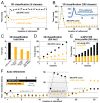Accelerated cryo-EM structure determination with parallelisation using GPUs in RELION-2
- PMID: 27845625
- PMCID: PMC5310839
- DOI: 10.7554/eLife.18722
Accelerated cryo-EM structure determination with parallelisation using GPUs in RELION-2
Abstract
By reaching near-atomic resolution for a wide range of specimens, single-particle cryo-EM structure determination is transforming structural biology. However, the necessary calculations come at large computational costs, which has introduced a bottleneck that is currently limiting throughput and the development of new methods. Here, we present an implementation of the RELION image processing software that uses graphics processors (GPUs) to address the most computationally intensive steps of its cryo-EM structure determination workflow. Both image classification and high-resolution refinement have been accelerated more than an order-of-magnitude, and template-based particle selection has been accelerated well over two orders-of-magnitude on desktop hardware. Memory requirements on GPUs have been reduced to fit widely available hardware, and we show that the use of single precision arithmetic does not adversely affect results. This enables high-resolution cryo-EM structure determination in a matter of days on a single workstation.
Keywords: GPU; biophysics; classification; cryo-EM; image reconstruction; micrograph; none; refinement; structural biology.
Conflict of interest statement
SHWS: Reviewing editor,
The other authors declare that no competing interests exist.
Figures












Similar articles
-
A Robust Single-Particle Cryo-Electron Microscopy (cryo-EM) Processing Workflow with cryoSPARC, RELION, and Scipion.J Vis Exp. 2022 Jan 31;(179). doi: 10.3791/63387. J Vis Exp. 2022. PMID: 35104261
-
New tools for automated high-resolution cryo-EM structure determination in RELION-3.Elife. 2018 Nov 9;7:e42166. doi: 10.7554/eLife.42166. Elife. 2018. PMID: 30412051 Free PMC article.
-
Sparseness and Smoothness Regularized Imaging for improving the resolution of Cryo-EM single-particle reconstruction.Proc Natl Acad Sci U S A. 2021 Jan 12;118(2):e2013756118. doi: 10.1073/pnas.2013756118. Proc Natl Acad Sci U S A. 2021. PMID: 33402531 Free PMC article.
-
Processing of Structurally Heterogeneous Cryo-EM Data in RELION.Methods Enzymol. 2016;579:125-57. doi: 10.1016/bs.mie.2016.04.012. Epub 2016 May 31. Methods Enzymol. 2016. PMID: 27572726 Review.
-
Advances in computational approaches to structure determination of alphaviruses and flaviviruses using cryo-electron microscopy.J Struct Biol. 2023 Sep;215(3):107993. doi: 10.1016/j.jsb.2023.107993. Epub 2023 Jul 4. J Struct Biol. 2023. PMID: 37414374 Review.
Cited by
-
Molecular basis of inhibition of the amino acid transporter B0AT1 (SLC6A19).Nat Commun. 2024 Aug 22;15(1):7224. doi: 10.1038/s41467-024-51748-1. Nat Commun. 2024. PMID: 39174516 Free PMC article.
-
Cryo-EM structure of ACE2-SIT1 in complex with tiagabine.J Biol Chem. 2024 Sep;300(9):107687. doi: 10.1016/j.jbc.2024.107687. Epub 2024 Aug 17. J Biol Chem. 2024. PMID: 39159813 Free PMC article.
-
Structures of Mature and Urea-Treated Empty Bacteriophage T5: Insights into Siphophage Infection and DNA Ejection.Int J Mol Sci. 2024 Aug 3;25(15):8479. doi: 10.3390/ijms25158479. Int J Mol Sci. 2024. PMID: 39126049 Free PMC article.
-
Comparison of structure and immunogenicity of CVB1-VLP and inactivated CVB1 vaccine candidates.Res Sq [Preprint]. 2024 Jun 28:rs.3.rs-4545395. doi: 10.21203/rs.3.rs-4545395/v1. Res Sq. 2024. PMID: 38978565 Free PMC article. Preprint.
-
Scaffold-enabled high-resolution cryo-EM structure determination of RNA.bioRxiv [Preprint]. 2024 Jun 10:2024.06.10.598011. doi: 10.1101/2024.06.10.598011. bioRxiv. 2024. PMID: 38915706 Free PMC article. Preprint.
References
-
- Abraham MJ, Murtola T, Schulz R, Páll S, Smith JC, Hess B, Lindahl E. GROMACS: High performance molecular simulations through multi-level parallelism from laptops to supercomputers. SoftwareX. 2015;1-2:19–25. doi: 10.1016/j.softx.2015.06.001. - DOI
-
- Chen S, McMullan G, Faruqi AR, Murshudov GN, Short JM, Scheres SH, Henderson R. High-resolution noise substitution to measure overfitting and validate resolution in 3D structure determination by single particle electron cryomicroscopy. Ultramicroscopy. 2013;135:24–35. doi: 10.1016/j.ultramic.2013.06.004. - DOI - PMC - PubMed
Publication types
MeSH terms
Grants and funding
LinkOut - more resources
Full Text Sources
Other Literature Sources

